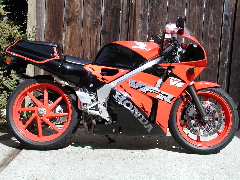 |
||||||||
|
Mike's Honda VFR400/RVF400 Page
|
||||||||
|
||||||||
|
VFR400/RVF400 Clutch Plate Information & Cross Reference The tables below show clutch plate part numbers for the Honda VFR400 (NC30) and RVF400 (NC35). There are several different clutch part numbers Honda used for these bikes, and all the different parts will fit. The problem is, if you fit the wrong parts, the clutch will be stiff, or slip. The important thing is that the entire clutch plate stack must be the correct thickness. Of course, Honda doesn't provide the thickness, just part numbers. There are three different stackups Honda used, one for the '89 NC30 (date code K), for the '90-'93 NC30 (date codes L and N), and for the NC35 (all years). There was another stackup used for the very early K model bikes, but that only affected the first 100 or so bikes made, and it is not covered here. If you have an early serial number NC30, then I suggest you refer to the original parts manual (see here) to verify that you are getting the correct parts. Here is a summary of the plates used for each bike. See the second table below for more specific details and some cross referenced parts available in the USA. I measured several plates and averaged the result to get the thickness.
Note the NC30 L and N, and NC35 all use the same fiber plates (3.06 mm). The NC35, however, uses a thicker metal plate (1.98 mm for NC35 vs. 1.58mm for the NC30 - all years). The NC30 K model bike used 8 fiber plates of one thickness and 2 of another. I don't have the thickness of the 8 fiber plates because I don't have an example I can measure, but the 22201-166-000 fiber plate (qty 2) has been superceeded by Honda with the VTR250 plate, part number 22201-GF6-000. I measured the VTR250 plate as 2.94 mm, so I assume the VTR plate is a similar thickness. I don't have any details (other than part number) on the other fiber plate (qty 8) used for the K model NC30, the 22201-MLO-781, so I don't know the plate's thickness. For my NC30 (model L and N), I have used Barrnet HP62-16 metal plates, and I have used Honda VTR250 fiber plates, all of which are easily obtained in the US. But, this was the wrong stackup. More recently, I started using the original Honda fiber plate for the NC30-L,N because of the slight thickness difference between the VTR plate and the NC30 plate. For street use, the thickness probably doesn't matter, but for the race track, the slightly thinner VTR250 plate doesn't offer as good of a clutch feel for launches at the starting line. The table below summarizes the different plates, what they are used for, quantities, and plate thicknesses. (Update Dec 17, 2006: I had the quantities wrong for the NC35 clutch plates - this has been updated.)
|
||||||||||||||||||||||||||||||||||||||||||||||||||||||||||||||||||||||||||||||||||||||||||||||||||||
Last Updated:
Email me at: mike@akhara.com